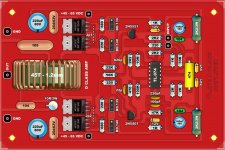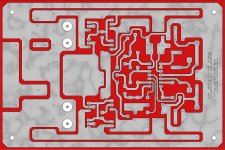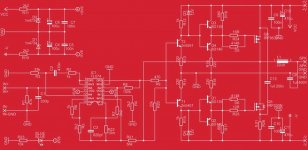2x65volt dc. voltage .. the output voltage is getting warmer ... 4 ohm when the transistors are warming .. Sound is good but .. What could be the cause? Is it necessary to interrupt the nucleus? For air flow? Is the voltage high? What is the reason ?
are the core start and end points important?
are the core start and end points important?
Attachments
2x65volt dc. voltage .. the output voltage is getting warmer ... 4 ohm when the transistors are warming .. Sound is good but .. What could be the cause? Is it necessary to interrupt the nucleus? For air flow? Is the voltage high? What is the reason ?
are the core start and end points important?
Use the amp at +-40volts and what output core material are you using?
As you made the drive-circuit yourself, a reason for heating is likely to be shoot-through effects. Short lasting but high current surges.
Next, the choke sees on one side ground level (without input signal) and on the other side a square wave signal with 130V amplitude changing polarity every 1-5 microsecond. An enormous magnetic cycling of the toroidal core that leaves important magnetic losses.
Solution: For the shoot-through it is difficult to avoid unless you use a monolithic driver or increase the dead-time. For the core - a bigger core with less magnetic losses. Or less supply voltage.
Next, the choke sees on one side ground level (without input signal) and on the other side a square wave signal with 130V amplitude changing polarity every 1-5 microsecond. An enormous magnetic cycling of the toroidal core that leaves important magnetic losses.
Solution: For the shoot-through it is difficult to avoid unless you use a monolithic driver or increase the dead-time. For the core - a bigger core with less magnetic losses. Or less supply voltage.
Last edited:
As you made the drive-circuit yourself, a reason for heating is likely to be shoot-through effects. Short lasting but high current surges.
Next, the choke sees on one side ground level (without input signal) and on the other side a square wave signal with 130V amplitude changing polarity every 1-5 microsecond. An enormous magnetic cycling of the toroidal core that leaves important magnetic losses.
Solution: For the shoot-through it is difficult to avoid unless you use a monolithic driver or increase the dead-time. For the core - a bigger core with less magnetic losses. Or less supply voltage.
You are using the same amplifier as in the thread ultra simple class d amplifier.
Use just one pair of mosfet and use a gap E core or micrometals T106-2. And u will be fine but i guess bd139/140 heat up badly. In my case it was so.
Knowing your core is difficult and I have the same problem but do not use +/-65V for supply.
In the past you bought your core from well known brands like Siemens (Europe) or other who published detailed data on how each core would behave. Core magnetization curves, core losses, saturation point etc....
Then you designed the chokes yourself from these data.
Today I buy the ready-made chokes from out east at a much lower price. But, I have no idea about how they will perform at high frequencies. I have a choke with a yellow-greenish core, stated to be able to handle 35A. Even in a rather low power class D amplifier it turns hot due to core-losses.
Often you find cores with different colors and if you know who made the core it may tell about its qualities. But, more manufacturers use such color coding but in a different way in Asia.
Today, I know of Japaneese manufacturers and US manufacturers that produce chokes for stock and provide datasheets. CoilCraft is one such manufacturer.
Either you buy (cheap) and try from Asia or you read and buy (more expensive) from manufacturers providing documentation.
In the past you bought your core from well known brands like Siemens (Europe) or other who published detailed data on how each core would behave. Core magnetization curves, core losses, saturation point etc....
Then you designed the chokes yourself from these data.
Today I buy the ready-made chokes from out east at a much lower price. But, I have no idea about how they will perform at high frequencies. I have a choke with a yellow-greenish core, stated to be able to handle 35A. Even in a rather low power class D amplifier it turns hot due to core-losses.
Often you find cores with different colors and if you know who made the core it may tell about its qualities. But, more manufacturers use such color coding but in a different way in Asia.
Today, I know of Japaneese manufacturers and US manufacturers that produce chokes for stock and provide datasheets. CoilCraft is one such manufacturer.
Either you buy (cheap) and try from Asia or you read and buy (more expensive) from manufacturers providing documentation.
Last edited:
You are using the same amplifier as in the thread ultra simple class d amplifier.
Use just one pair of mosfet and use a gap E core or micrometals T106-2. And u will be fine but i guess bd139/140 heat up badly. In my case it was so.
No, I have not tried the Ultra Simple Class D. I can assure you that doing high frequency push-pull switching with a rather optimal take-over and without significant shoot-through is a science. This is why designers often choose for monolithic drivers.
I have quite a lot of BD139/140. Do you run them at 130V!?
When I asked if you used BD139/140 at 130V, and did not get a reply, I checked your board layout. It seems you are using IRF540. I checked the datasheets from NXP, ST and Fairchild. It should be rated for 100V.
Do you use IRF540 with a +/-65V supply?
This is not my post. And this board is not designed to be used above 50-0-50v dc. So you have your answer.
This is not my post. And this board is not designed to be used above 50-0-50v dc. So you have your answer.
Thanks for the clarification.
Is it normal for the core to warm up? The high currents are sinusoidal with the square wave Lc Filter. Because the magnetic field will pass through this process? Or am I ever going to be normal?
Little warmth is not an issue.
Yes, cores heat up.
Core loss = heat. You also get power loss from IR in the wire. That too = heat. As an example, Mag-inc has a funky (empirical) temperature rise vs loss formula that is supposed to get you close to expected temperature rise, given the total loss. When you design your inductor, you should consider temperature rise.
If you're careful, you will design the inductor so as it doesn't violate Faraday's law, or Ampere's law. You'd probably like to operate at the lowest flux density you can. Large delta-B is a direct heat source. Copper losses also are your enemy.
I don't care for those off-shore cores with lousy data...I don't trust them. Mag-Inc (I don't work there) has a lot of really good cores. You can't buy just 1 or 2 but probably can get samples if you ask nicely. You can also buy small quantities from distribution.
Anyway - if you just aren't sure about any of this stuff....just use a bigger core and hope for the best
Core loss = heat. You also get power loss from IR in the wire. That too = heat. As an example, Mag-inc has a funky (empirical) temperature rise vs loss formula that is supposed to get you close to expected temperature rise, given the total loss. When you design your inductor, you should consider temperature rise.
If you're careful, you will design the inductor so as it doesn't violate Faraday's law, or Ampere's law. You'd probably like to operate at the lowest flux density you can. Large delta-B is a direct heat source. Copper losses also are your enemy.
I don't care for those off-shore cores with lousy data...I don't trust them. Mag-Inc (I don't work there) has a lot of really good cores. You can't buy just 1 or 2 but probably can get samples if you ask nicely. You can also buy small quantities from distribution.
Anyway - if you just aren't sure about any of this stuff....just use a bigger core and hope for the best
- Status
- This old topic is closed. If you want to reopen this topic, contact a moderator using the "Report Post" button.
- Home
- Amplifiers
- Class D
- 200w Class D Ferrite Core Heating


